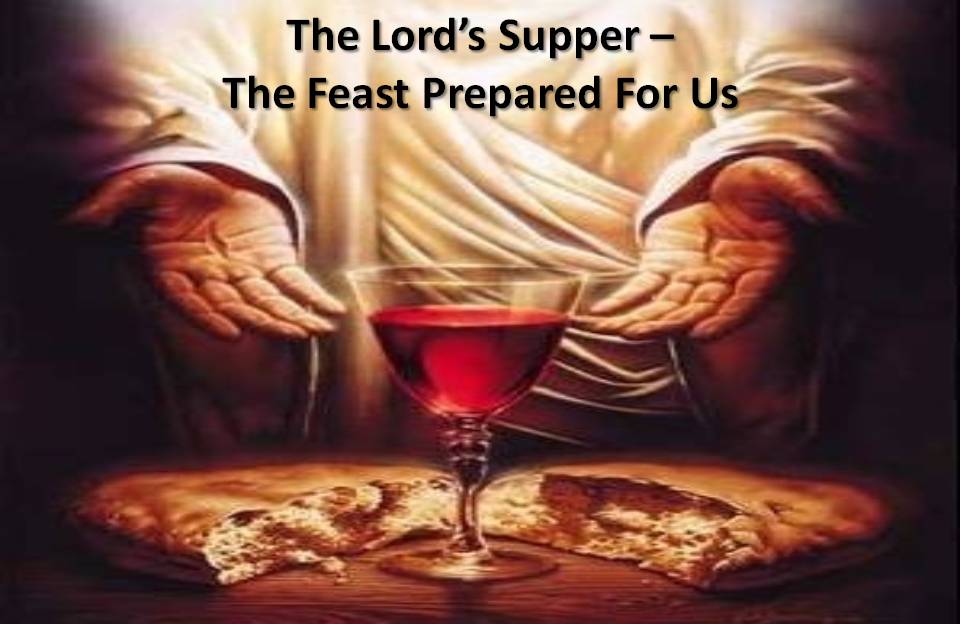 |
| Unleavened bread and Fruit of the Vine |
THE LORD’S SUPPER
INTRODUCTION: The Lord’s Supper is one of the most
beautiful and significant doctrines of the Bible. It is the picture left by the Bridegroom (Christ) with His
fiancee (the church) to be viewed in every
age until His return for the marriage.
I. The origin of the supper
A. Initiated by Jesus, Matthew 26:26-29
1. This supper took place just prior to Jesus’
arrest and crucifixion.
2. It was the last intimate gathering of
Christ and His church.
3. Jesus was burdened about the sorrow that
would come to His church after He would
depart, John
14:1-3.
4. He was concerned about the tribulation that
they would face in the world, John 17.
B. The purpose of the supper
1. It was given to the church to remember His
death until He returns.
2. The supper is a picture that we have to
ease the sorrow and the tribulation in every
age, fortifying our
hope of His soon return.
II. The recipients of the supper
A. The recipients are Jesus’ called out
assembly, gathered together in one place with Christ
as the Head of that
body.
1. Not all the saved, but only His church, was
gathered together at the time Christ
instituted the
Lord’s Supper.
2. It is important to understand that the
supper is a picture for the church. The signifi-
cance of the
picture applies only in reference to the relationship of Christ and His
Bride.
a. An
engaged man taking a far journey does not leave pictures with several women
but only with his fiancee.
but only with his fiancee.
b. The Lord’s Supper deals with the shed blood
and broken body of Christ, which
is the means of salvation for all mankind. However, the picture that He gave to
His church reveals the entire purpose of His sacrifice, which proclaims in a spe-
cial way His death for His Bride, Acts 20:28; Ephesians 5:25.
is the means of salvation for all mankind. However, the picture that He gave to
His church reveals the entire purpose of His sacrifice, which proclaims in a spe-
cial way His death for His Bride, Acts 20:28; Ephesians 5:25.
B. This is a church
ordinance, and we are told as often as we observe it, do it in remem-
brance of Him, I Corinthians 11:23-26.
brance of Him, I Corinthians 11:23-26.
1. Each
individual must cleanse himself before participating in the supper,
I
Corinthians 11:28,29.
2. As
this ordinance pictures the Bridegroom, it draws our attention to the need of
being
faithful to Him.
III. The elements of the supper.
A. Unleavened bread
1.
Luke
22:19 does not say that the bread was unleavened, but we know that He was
using a loaf from the Passover, which,
according to Exodus 12:15, was commanded to be unleavened bread; violation of
this brought the penalty of death.
2. Leaven in the Scriptures represents sin, I
Corinthians 5:6.
3. The supper cannot
be taken without purging the body of sin, I Corinthians 5:7.
4. The loaf represents
the body of Christ, comprised of members of that body,
I Corinthians 10:17; I Corinthians 12:12,14.
B. The
fruit of the vine
1. This represents the blood of Jesus, shed
for us, Matthew 26:28.
2. It
also represents the abundant life that the believer can have in the church (His
body),
John 10:10.
IV. The restrictions of the
supper
A. It can only be observed in church capacity,
I Corinthians 11:18.
B. Only faithful members of the local church
can participate.
1. Remember, it is the Lord’s table, I
Corinthians 10:21.
2. The Lord makes the rules, determining who
can sit at His table.
3.
If
any brother is a fornicator, covetous, an idolator, a railer, a drunkard, or an
extor-
tioner, we are
commanded not to eat the supper with him, I Corinthians 5:11. (In
fact, we are told to put him out of the membership, verses 4 and 5.)
4. We are instructed not to observe the Lord’s Supper if there are divisions in the
church, I Corinthians 11:18.
fact, we are told to put him out of the membership, verses 4 and 5.)
4. We are instructed not to observe the Lord’s Supper if there are divisions in the
church, I Corinthians 11:18.
5. We are not to eat
with those who are not doctrinally sound, I Corinthians 11:19;
Romans
16:17.
6.
The Lord’s Supper
is not to be taken with those of other faiths, II John 9-11.
7.
With
these restrictions in view, it becomes evident that it is not possible to take
the
Lord’s Supper with other churches even though they are of like
faith and order.
a. How can we know if the
members of another church are in unity?
b. How do we know whether
they are excluded or not?
c. If they are members of another church body,
how can this church discipline
their lives?
their lives?
d. How can we invite those who are not part of
the body to participate if there can
be no divisions in the body when the supper is taken?
be no divisions in the body when the supper is taken?
V. The blessings of the supper
A. It is a time of
cleansing and renewing for both the church and the individual members
and a time to draw closer in our union with Christ.
and a time to draw closer in our union with Christ.
B. It
is a time to look at the picture of the Bridegroom in anticipation of His soon
return and
the marriage of the Lamb, Revelation 19:7,8.
the marriage of the Lamb, Revelation 19:7,8.

